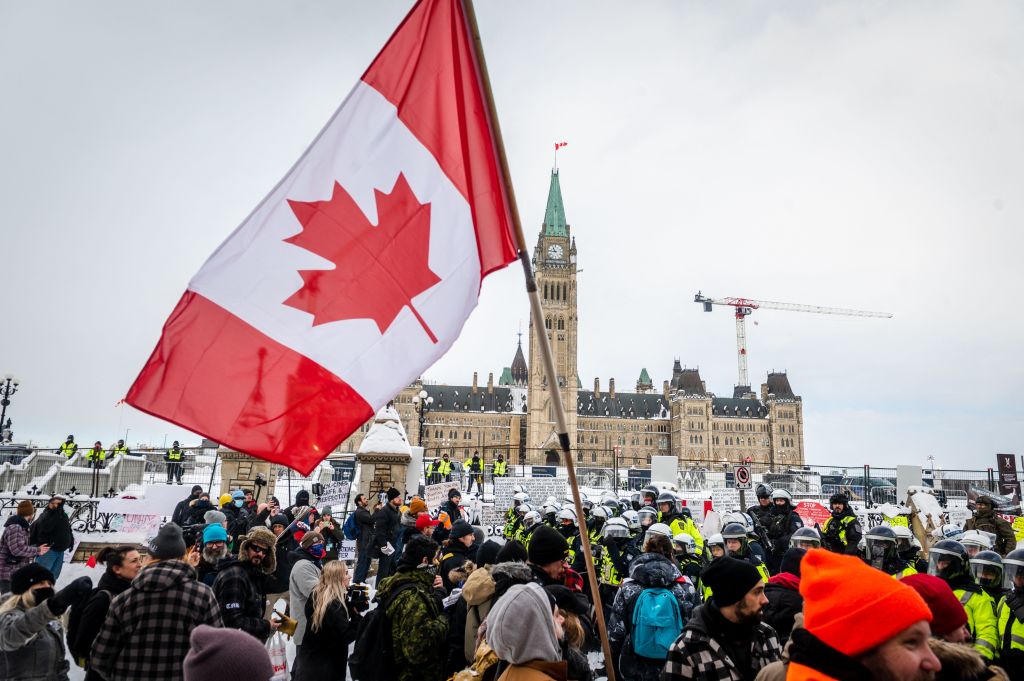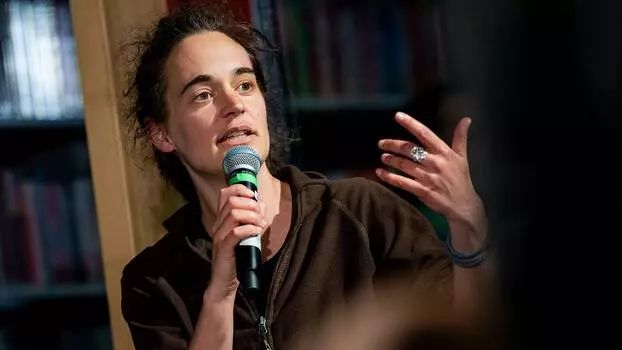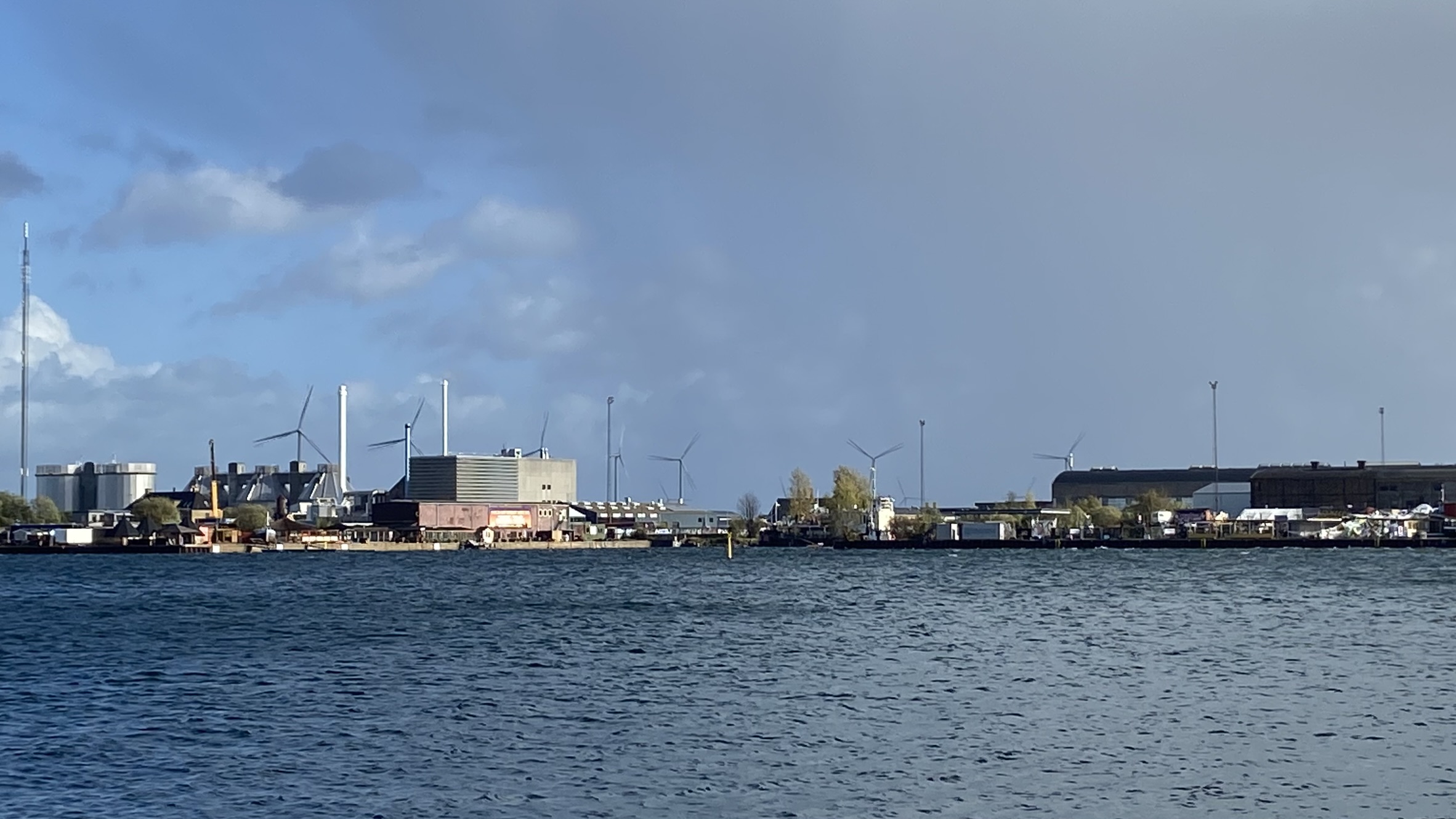An assessment by Stefan Liebich, Fellow of the Rosa Luxemburg Stiftung New York Office.
“It is high time that these illegal and dangerous activities stop,” said Canada’s Prime Minister Justin Trudeau. On Friday, February 18, the clearing out began. Police informed downtown Ottawa squatters* in their trucks that they would have to go home or otherwise face stiff fines, loss of the ability to work across borders and even imprisonment. Then police made the first arrests. Some trucks moved to leave the city, others vowed to stay. Protesters planned to barricade themselves in their trucks. Forced removal would be a logistical Herculean task, given the weight of the vehicles and the weather conditions—it’s snowing and close to 0 degrees Fahrenheit (minus 15 degrees Celsius).
What took place here in the last few weeks surprised many at home and abroad, as it contradicted the image of the nice Canadians and their constitutional principle of “peace, order and good governance.”

Flashback.
It began four weeks ago. Truck convoys formed in various places across Canada, then met in the capital on January 29 to demonstrate for “Freedom.” The “Freedom Convoy” was born.
The original reason for the demonstrations was a Canadian government mandate that truck drivers be vaccinated against COVID-19 if they wanted to work in cross-border transport. Fully 90 percent of Canada’s truckers had no problem with this and are vaccinated. Across the border in the U.S., infection rates have skyrocketed at times, in part due to Republican anti-vaccination activists who are in charge in some states. But for a Canadian minority, the mandate was the straw that broke the camel’s back. Soon the protests were not just against this measure but “against masks, against vaccination in general, against science, against Trudeau, against everything,” Justin Ling, a Canadian journalist and much-sought-after interview partner these days, told me.
The protests were led by James Bauder, Tamara Lich and Benjamin Dichter, among others, who believe in Trump’s election fraud conspiracy and George Soros’s responsibility for the coronavirus and sympathize with the secession of Western Canada or the radical right-wing People’s Party of Canada.
The fact that the not-so-numerous protesters made such a big impression is largely due to the trucks that managed to blockade the city and major lifelines. But how was it possible that this happened without resistance from the state? Some observers assume that the police expected the demonstrators to come, make their case and then leave, as has usually been the case in Ottawa. Natasha Lennard of the left-wing website The Intercept goes further, accusing law enforcement of “helping the right-wing-led protesters set up camp in front of the Canadian Parliament with their low-key approach.” Videos even show some police officers offering support to the protesters. On more than one occasion, police officers have moved counter-demonstrators out of the way as convoys of trucks joined the blockade.” In the past, Canadian police have not shied away from using force at leftist or Indigenous protests. On the contrary.
It soon became clear that conservatives in North America, all the way to the right edge of the political spectrum, were using the movement for their own purposes, funding it and cheering it on. The People’s Party, the far-right Canadian Nationalist Party, the right-wing fringe of Canadian conservatives and U.S. Republicans rushed to the rescue in support. The truckers were supported by Donald Trump, Ted Cruz and Marjorie Taylor Greene, and also by right-wing media stars like Tucker Carlson and his Fox News network, who “analyzed” the arrests as they began: “They could have used that logic against the civil rights movement. They could have arrested Martin Luther King.” (King served time in prison several times.) And the right-wing backstop has consequences. USA flags that patriotic Canadians actually dislike, Confederate Southern flags from the U.S. Civil War, and even swastika flags are on display, and it’s easy infer anti-Muslim, white supremacist sentiment. QAnon and Bill Gates conspiracy narratives meet sympathy here. Some of the protesters aren’t truckers either, but strapping right-wingers.
It would be too easy to dismiss the whole thing as a fringe right-wing US event. There are also mainstream workers, families, even yoga teachers there. It’s a mix. Some of it seems like a peaceful Woodstock, some of it aggressive. The desperation of many protesters is real. They report business closures, unemployment and suicides. The Canadian government has tried to counteract the effects of the pandemic with massive aid programs, and a general increase in suicide figures in Canada has not yet been apparent. But one cannot rule out the possibility that this was the case in certain regions or groups. And the anger at the fact that the pandemic is not affecting everyone equally is palpable. People working on their new Macbooks in their home offices feel the effects of Covid differently than a large family in a small apartment whose sole breadwinner can’t work.
Protests like this cost money. Lost earnings, heating, food, shelter, media relations. That’s why attention soon turned to the financiers—rich Canadians and US Americans. Indeed, some of those financing the protests believed communism was threatening Canada or had already arrived. Mitchell Thompson quotes for “PressProgress” an entrepreneur who donated money: “In the last two years, Canada has begun to become a communist country. We have dictators at the federal and provincial levels.” But billionaires like Elon Musk also attack Canada’s Trudeau government, not even shying away from Hitler memes. The opposition social democratic New Democratic Party (NDP) immediately took advantage of the skepticism of most Canadians toward its large US neighbor to call for a ban on funding from the neighboring country. Justin Ling, however, believes this is wrong and overblown. “It’s a Canadian protest, not a US protest. It would have happened without US influence. I’m more surprised that more money didn’t flow from the US.”
After a few days, other consequences of the blockades were felt in addition to the blockade of Ottawa’s downtown. The Ambassador Bridge between the US and Canada, a major lifeline for the Canadian economy, was shut down, leading to empty shelves and even plant shutdowns due to a lack of supplies.
When some protesters started taking food away from homeless people in a soup kitchen in Ottawa and insulted its staff, people had enough. There were counter-protests and demands for an end to the blockade.
Pressure increased in politics as well, initially within the Conservative Party in Canada’s parliament. The back-and-forth in dealing with the protests forced its leader, Erin O’Toole, who was already ailing, to withdraw. His interim successor, Candice Bergen, could be seen wearing a “Make America Great Again” cap and immediately sided with the protesters. Naturally the politicians would be drawn to the protesters’ ability to mobilize money and activists. One can assume a further shift to the right. Even if a moderate part of the party wants to keep its distance from the right-wing fringe, other MPs have long since taken selfies with them.
Prime Minister Trudeau and his Liberals used this rightward drift to distance themselves from the protests and steal voters from Conservatives in the political center. Still there’s also the accusation against the Liberals that this was precisely why they watched the goings-on for so long.
Jagmeet Singh, the leader of the NDP, believes that this is more than a protest movement. Instead, “the stated intention of the convoy was to overthrow the government,” which was what their banners said. The NDP’s course is, on the one hand, to criticize the government for not looking out for the interests of ordinary Canadians during the pandemic, preferring to protect the rich. But it also calls for a tougher approach to the protests and supports emergency regulations.
Not everyone on the left shares this assessment. On the one hand: “The ‘Freedom Convoy’ is not a protest of the working class. It is not a protest that aims to fight exploitation or the rule of capital. It certainly does not seek to help migrants, indigenous people or minorities whose freedom has never been recognized,” writes Bryan D. Palmer for Verso. What is clear is that the “freedom” they mean is a purely individual one. They care nothing for the rights to health and life of others endangered by the transmission of the virus. “The ‘Freedom Convoy’ is not a fight for the freedom of all, but an attempt to destroy democracy in the name of freedom,” Palmer says. Incidentally, the “freedom” of European settlers to bring disease and pestilence to the Americas helped to nearly wipe out the people who already lived there.
On the other hand, the fact that Prime Minister Justin Trudeau has declared a national emergency for the first time in half a century is not good news from a leftist perspective. It gives the Canadian government extraordinary powers, including overriding the right to public assembly and allowing it to ban people believed to be participating in the protests from using financial institutions.
“There is nothing for the left to support in invoking these repressive powers,” warns Natasha Lennard. “These same measures are being used to suppress the movements we support. Poor, marginalized and racially oppressed populations.”
“The fact that the anti-mandate movement was smart enough to mobilize convoys, occupations and blockades at the very time that many Conservative-led provincial governments were already preparing to dismantle vaccination and mask regulations means that the radical right will claim this as their victory and continue to use it. That and the dollars flowing into their secret coffers will only fuel the anger. This, unfortunately, is the political soil of our time,” states Bryan D. Palmer.
***
Author’s note: Since I was not in Ottawa myself while in Canada, I used conversations with journalists* Justin Ling, Andrea Levy and C.J. Atkins, as well as the following articles, for this analysis:
https://truthout.org/articles/convoy-movement-isnt-a-struggle-over-freedom-its-an-attempt-to-kill-democracy/
https://theintercept.com/2022/02/16/canada-protests-freedom-convoy-ottawa/
https://pressprogress.ca/we-are-fed-up-wealthy-business-people-who-donated-to-far-right-convoy-believe-they-are-oppressed
https://www.versobooks.com/blogs/5268-freedom-comes-to-canada



